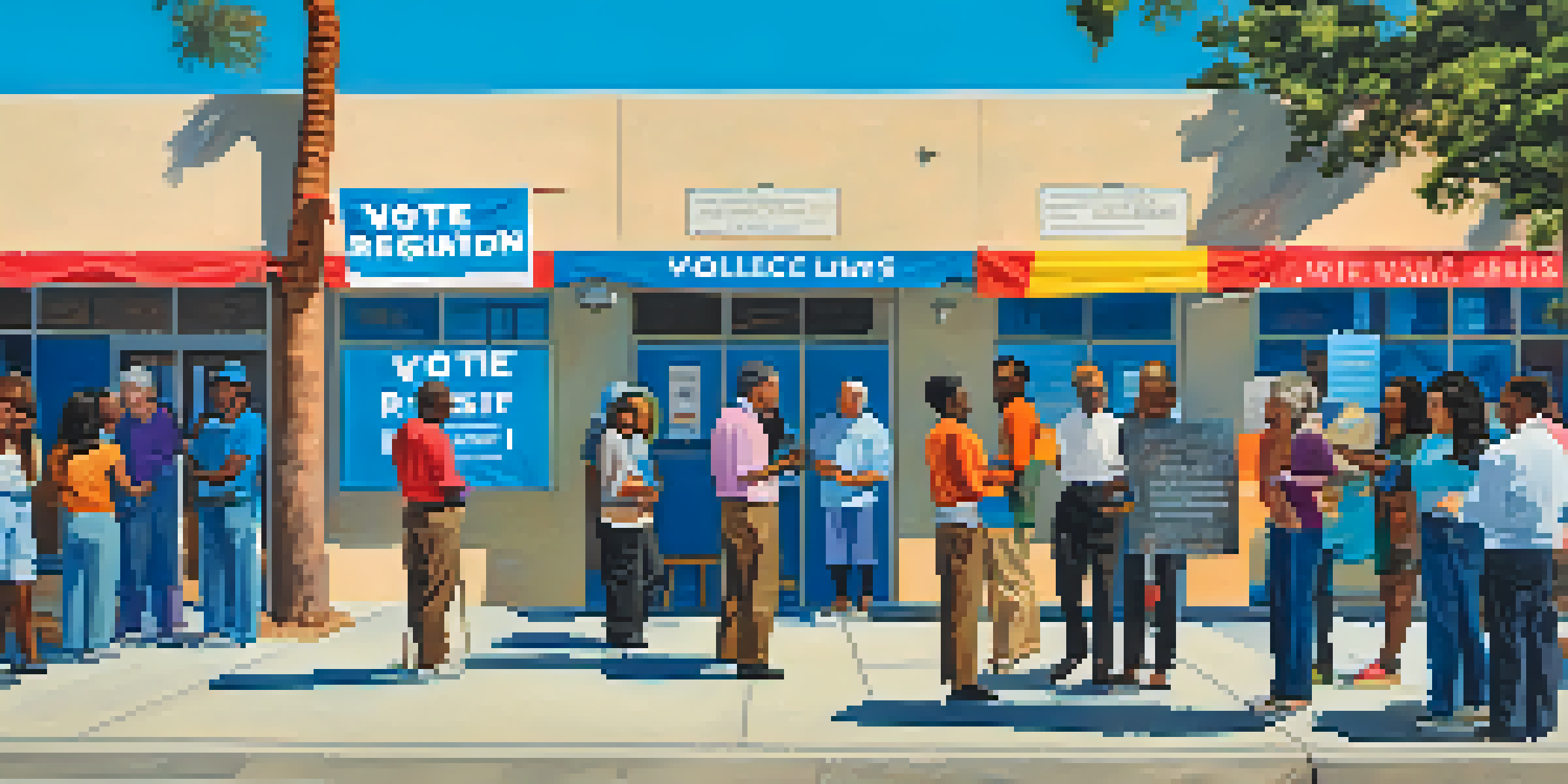Exploring Barriers to Voter Participation in Los Angeles

Understanding the Importance of Voter Participation
Voter participation is the lifeblood of a functioning democracy, and this is especially true in a diverse city like Los Angeles. When citizens engage in the electoral process, they have a say in the policies that affect their lives and communities. However, low turnout can lead to decisions that do not reflect the will of the people, creating a disconnect between government and its constituents.
The future of this republic is in the hands of the American voter.
In Los Angeles, the significance of voting extends beyond just local elections; it shapes everything from education funding to public safety measures. Yet, many residents feel their votes do not matter, leading to apathy and disengagement. Understanding why some groups do not participate is crucial for fostering a more inclusive democracy.
By addressing the barriers that prevent voter participation, we can take steps toward a more equitable society. This requires a collective effort from community leaders, organizations, and policymakers to ensure every voice is heard and valued.
Socioeconomic Factors Impacting Voter Turnout
Socioeconomic status plays a vital role in voter participation, particularly in a city as large and varied as Los Angeles. Individuals from lower-income backgrounds often face challenges that can hinder their ability to vote, such as lack of time, resources, and access to information. These barriers can create a cycle of disenfranchisement that persists across generations.

For instance, working multiple jobs to make ends meet can leave little time for individuals to research candidates or even make it to the polls. Additionally, those living in economically disadvantaged neighborhoods may lack transportation options, making it difficult to reach polling places. These logistical issues can deter even the most passionate voters from participating.
Voter Participation is Crucial
Engaging in the electoral process allows citizens to influence policies that directly affect their lives and communities.
Addressing these socioeconomic barriers is essential for increasing voter turnout. Initiatives that provide resources, transportation, and information can empower marginalized communities and ensure their voices contribute to the electoral process.
Cultural Barriers to Engaging Diverse Communities
Los Angeles is a melting pot of cultures, which can both enrich and complicate voter participation. Language barriers, cultural differences, and varying levels of trust in government can create obstacles for many residents. For instance, non-English speakers may struggle to understand ballots or voter registration materials, leading to confusion and frustration.
Voting is not only our right—it is our power.
Moreover, some communities have historical reasons for distrust in the electoral system, stemming from past injustices and disenfranchisement. This skepticism can discourage individuals from participating in elections, as they may feel that their votes won't lead to meaningful change. Building trust with these communities is crucial for fostering engagement.
To combat these cultural barriers, outreach efforts should be tailored to the specific needs of diverse populations. By providing multilingual resources and culturally relevant education, organizations can help demystify the voting process and encourage greater participation.
The Role of Education in Voter Participation
Education is a powerful tool in promoting voter participation, yet not all individuals receive the same level of civic education. Many schools in Los Angeles do not prioritize teaching students about the importance of voting, which can lead to a lack of understanding about how elections impact their lives. This knowledge gap can result in lower turnout rates among younger generations.
Furthermore, adults who missed out on civic education in their youth may feel unprepared to participate in elections. They might not know how to register, where to vote, or what the issues at stake are. This can perpetuate a cycle of disengagement that affects entire communities.
Socioeconomic Barriers Persist
Lower-income individuals often face significant challenges that hinder their ability to vote, perpetuating disenfranchisement.
To bridge this gap, comprehensive civic education programs should be integrated into both K-12 curricula and adult education initiatives. Empowering individuals with the knowledge and skills to navigate the electoral process can lead to increased voter participation and a more informed electorate.
Access to Voting: Logistics and Infrastructure
Access to voting is a fundamental right, yet many residents of Los Angeles encounter logistical challenges that can prevent them from casting their ballots. Issues such as long lines at polling places, limited hours, and insufficient voting machines can create barriers for voters. These obstacles can be particularly daunting for those with disabilities or caregiving responsibilities.
Additionally, the process of registering to vote can be confusing, with different rules and requirements depending on one’s situation. Many potential voters may not know how to navigate these regulations, leading to frustration and lower turnout rates. Ensuring that the voting process is clear and accessible for everyone is crucial.
Improving infrastructure—like increasing the number of polling places and extending voting hours—can help alleviate some of these concerns. By making voting more convenient and accessible, we can encourage higher participation rates across all demographics in Los Angeles.
The Influence of Misinformation on Voter Engagement
In today's digital age, misinformation can spread like wildfire, impacting voter engagement in profound ways. Many residents in Los Angeles may encounter false information about voting procedures, dates, and requirements, which can lead to confusion and, ultimately, discourage participation. This spread of misinformation can disproportionately affect marginalized communities who may rely on social media for information.
When potential voters are misled about how to register or when to vote, they may become disheartened and choose not to participate. This can create a significant gap in electoral turnout, particularly among younger voters who are more likely to consume information online. Combatting misinformation is essential to ensure that all citizens have the correct information they need to participate in elections.
Education Enhances Civic Engagement
Comprehensive civic education is essential for empowering individuals with the knowledge needed to participate effectively in elections.
To counteract this issue, organizations and community leaders should prioritize accurate information dissemination. Creating easy-to-understand materials and utilizing trusted local voices can help clarify the voting process and combat the spread of misinformation.
Community Initiatives to Enhance Voter Engagement
Community initiatives play a pivotal role in enhancing voter engagement in Los Angeles. Local organizations often lead the charge by providing resources and organizing events to educate residents about the voting process. These grassroots efforts can empower individuals and create a sense of community around civic participation.
For example, some groups host workshops to help people navigate the registration process or understand ballot measures. Others may organize transportation services to polling places, ensuring that logistical barriers are minimized. By fostering a culture of participation, these initiatives can inspire others to get involved and make their voices heard.

Collaborating with local leaders and influencers can further amplify these efforts. By leveraging trusted community members to promote voter engagement, initiatives can reach a wider audience and create lasting change in participation rates.
Moving Forward: Strategies for Increased Voter Participation
To address the barriers to voter participation in Los Angeles, a multi-faceted approach is necessary. This includes improving education about the voting process, enhancing access to polling places, and combating misinformation. Only by tackling these challenges head-on can we hope to see a significant increase in voter turnout.
Engaging with community leaders and organizations is crucial for creating targeted strategies that resonate with diverse populations. By listening to the needs of residents, we can develop initiatives that specifically address their concerns and barriers to participation. This collaborative effort can foster a sense of ownership over the electoral process.
Ultimately, increasing voter participation is not just about getting people to the polls; it's about ensuring that every voice is heard in our democracy. With concerted efforts and a commitment to inclusivity, Los Angeles can pave the way for a brighter, more engaged future.